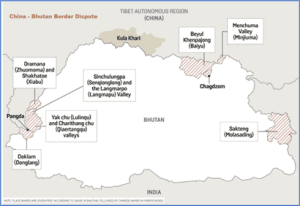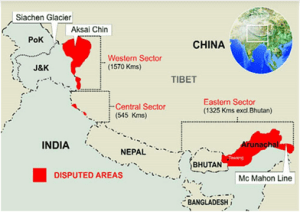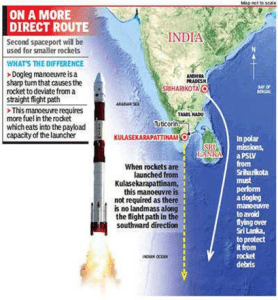TOP 5 TAKKAR NEWS OF THE DAY (7th NOVEMBER 2023)
1. CENTRAL INFORMATION COMMISSION
TAG: GS 2: POLITY AND GOVERNANCE
THE CONTEXT: Recently, Chief Information Commissioner & two new Information Commissioners have been appointed in Central Information Commission.
EXPLANATION:
- Mr Heeralal Samariya has been appointed as the Chief Information Commissioner in the Central Information Commission.
- A swearing-in ceremony was organized in the Central Information Commission to officially administer the oath of office to the new Chief Information Commissioner and Information Commissioners.
- This ceremony marks the formal assumption of their duties.
ISSUES:
- The appointment of the Chief Information Commissioner has become a contentious issue, with allegations of lack of transparency, pre-determined decisions, and a disregard for democratic norms.
- The current situation deepens the trust deficit between the Opposition and the Centre, which can impact the functioning of democratic institutions and the transparency and accountability of the government.
>Lack of Consultation:
- Opposition member in the selection committee is not being consulted or informed about the selection of the CIC, as required by the Right to Information Act, 2005.
- This has raised concerns about the government’s commitment to democratic norms and traditions.
- The MP stressed the importance of involving the Opposition in the selection process to maintain democratic traditions and norms.
- He urged the President to take measures to ensure that the Opposition’s role is not diluted in such crucial appointments.
- The names of the selected candidates were announced and sworn into office shortly after the meeting. This raises questions about the transparency and fairness of the selection process.
>Vacancies:
- The Supreme Court has expressed its dissatisfaction with the failure of states and the Union government to fill the vacancies in Information Commissions across the country.
- Maharashtra SIC is without a Chief and functioning with only 4 commissioners even though more than 1,15,000 appeals/complaints are pending.
- Jharkhand SIC has been completely defuncted since May 2020 and no appeals/complaints are being registered or disposed for the last three years.
- Tripura SIC has been defuncted for more than 2 years since July 2021.
- Telangana SIC has been defuncted since February 2023 even though more than 10,000 appeals/complaints are pending.
- There are many examples like this that has been presented regarding the vacancies.
JUDGEMENT BY THE SUPREME COURT:
- The Supreme Court emphasized that the failure to fill these positions defeats the purpose of the RTI Act.
- This Act is a crucial tool for citizens to access government information, and vacancies in the Information Commissions can lead to delays and hinder the right to information.
- The Supreme Court directed the Department of Personnel and Training (DoPT) to prepare a chart detailing the number of vacancies and pending appeals/complaints in all the commissions.
- It also ordered the central and state governments to take immediate action to fill these vacancies.
- It also highlighted issues such as commissions operating without a Chief, significant backlogs of appeals and complaints, and some commissions being entirely defunct for extended periods.
- The matter is scheduled to be heard by the Supreme Court after three weeks, indicating that the Court is taking the issue seriously and expects prompt action.
- The Supreme Court’s directive addressed the critical role of Information Commissions in upholding the right to information and the need for timely appointments to ensure their effective functioning.
CENTRAL INFORMATION COMMISSION (CIC):
- The CIC was established by the Central Government in 2005, under the provisions of the Right to Information Act (2005).
- It is not a constitutional body.
- It consists of a Chief Information Commissioner and not more than ten Information Commissioners.
- They are appointed by the President on the recommendation of a committee consisting of the Prime Minister as Chairperson, the Leader of Opposition in the Lok Sabha and a Union Cabinet Minister nominated by the Prime Minister.
- The jurisdiction of the Commission extends over all Central Public Authorities.
- The Chief Information Commissioner and an Information Commissioner shall hold office for such term as prescribed by the Central Government or until they attain the age of 65 years, whichever is earlier.
- They are not eligible for reappointment.
POWER AND FUNCTIONS OF CIC:
- To receive and inquire into a complaint from any person regarding information requested under RTI, 2005.
- It can order an inquiry into any matter if there are reasonable grounds (suo-moto power).
- While inquiring, the Commission has the powers of a civil court in respect of summoning, requiring documents etc.
2. CNEMASPIS RASHIDI
TAG: GS 3: ECOLOGY AND ENVIRONMENT
THE CONTEXT: Recently, the researchers have discovered a previously undocumented species of gecko, making it the 94th known species of gecko.
EXPLANATION:
- The discovery was made by a team of researchers led by senior scientist of the Wildlife Protection and Research Society, Maharashtra.
- It was a collaborative effort involving scientists from various organizations, including the Bombay Natural History Society, Ashoka Trust for Research in Ecology and the Environment, Help Earth, and InSearch Environmental Solutions.
- The research paper on this new species was published in the Asian Journal of Conservation Biology.

CNEMASPIS RASHIDI:
- The newly documented gecko species has been named Cnemaspis rashidi in honour of Prof. Rashid Sayyed, Amit Sayyed’s father.
- This particular gecko is referred to as Rashid’s dwarf gecko due to its small size, measuring approximately two inches from snout to vent.
- The new gecko species was discovered in the Western Ghats near Rajapalayam, at an altitude of 1,245 meters at Kottamalai estate.
- The Western Ghats are known for their rich biodiversity.
- This new gecko species is distinctive due to its beautiful colour pattern of yellow, white, and black on its back.
- It also features deep brown eyes, giving it an almost ethereal quality.
- These characteristics set it apart from other gecko species.
- Conservation Significance:
- The gecko is described as being endemic to the Western Ghats, which means it is found exclusively in this region.
- Researchers pointed out that the discovery of this new gecko species adds another reason to conserve the rich biodiversity of the Western Ghats.
- It emphasized the need for preserving the unique and often vulnerable species found in this region.
3. LAMPREY SPECIES
TAG: GS 3: ECOLOGY AND ENVIRONMENT
THE CONTEXT: Recently, Chinese palaeontologists have discovered two new lamprey species from fossils that date back approximately 160 million years.
EXPLANATION:
- The fossils of these lamprey species were found in a fossil bed in North China.
- The larger species is named Yanliaomyzon occisor, with “occisor” meaning “killer” in Latin, while the smaller species is named Yanliaomyzon ingensdentes, which refers to “large teeth” in Latin.
- The fossils were well-preserved, enabling scientists to study their biting structures and oral discs.

LAMPREY SPECIES
- Lampreys are jawless fish known for their parasitic feeding behaviour, but these newly discovered species exhibited a different, more aggressive feeding behaviour by scooping out flesh from their prey.
- Lampreys are eel-like jawless fish that are typically associated with being parasitic, using their unique mouths and sharp teeth to attach to other organisms and feed on their blood.
- What makes these new lamprey species remarkable is their behaviour.
- Instead of solely feeding on blood, these ancient lampreys were flesh eaters.
- They were capable of scooping out flesh from their prey and had a powerful bite that could even break their prey’s skeletons.
- This discovery challenges the conventional view of lampreys as “water vampires.”
EVOLUTIONARY SIGNIFICANCE:
- These recently discovered lamprey species lived during the Jurassic period alongside dinosaurs.
- They are considered a missing link between the earliest lampreys and the 31 surviving lamprey species known today.
- The earliest lamprey fossils date back to around 360 million years ago, during the Paleozoic era.
- These ancient lampreys were considerably smaller and had underdeveloped feeding structures, suggesting that they did not feed on blood or flesh.
- Additionally, they did not undergo metamorphosis, which is a notable contrast with modern lampreys.
4. BREACHING OF THE DATA
TAG: GS 3: INTERNAL SECURITY
THE CONTEXT: An American cybersecurity company, Resecurity, reported that the Personally Identifiable Information (PII) of 815 million Indian citizens, including sensitive information like Aadhaar numbers and passport details, was being offered for sale on the dark web.
DATA BREACH AND DARK WEB SALE:
-
- An American cybersecurity company, Resecurity, revealed that the personal data of 815 million Indian citizens was available for sale on the dark web.
- This data included sensitive details such as Aadhaar numbers and passport information.
- Threat actors were offering this data for $80,000, indicating a significant demand for the personal information of Indian citizens.
- Nature of Personally Identifiable Information (PII):
- Personally Identifiable Information (PII) is data that can be used to identify an individual.
- It can be either directly or in conjunction with other data.
- In this case, the breached data contained Aadhaar numbers, a 12-digit identification number issued by UIDAI, and passport details.
- Sources of the Breach:
- The threat actors did not disclose how they obtained the data.
- One of them claimed the data originated from the Indian Council of Medical Research (ICMR).
- While another mentioned access to an unnamed “India internal law enforcement agency.”
- However, the legitimacy of these claims remains uncertain.
- Government Response:
- The government of India is taking steps to investigate the data breach.
- The Computer Emergency Response Team is involved in this effort.
- The government is also working on enhancing its data management systems.
- The extent of the alleged breach has not been specified yet.
- Security of PII Data:
- The security of PII data, particularly Aadhaar information, has been a point of concern.
- The Unique Identification Authority of India (UIDAI) claims that all Aadhaar data is safe and secure in its Central Identities Data Repository (CIDR) and has never been breached.
- However, there have been past reports of data breaches, raising doubts about the security of such information.
- Cyber Threats and Identity Theft:
- Various threats have been arising from the leaked information.
- It notes that India has witnessed a rise in disruptive cyberattacks, making PII data particularly attractive to threat actors.
- The exposure of personal data significantly increases the risk of digital identity theft.
- It can be exploited for various cybercrimes, including online banking theft and tax fraud.
- User Safeguards:
-
- Try to ascertain if their data was part of the breach.
- Be cautious of emails from unknown sources, as this information can be used in phishing campaigns.
- Change user IDs and passwords to prevent the misuse of stolen data.
- Implement two-factor authentication to enhance the security of online accounts.
- Report any suspicious online account activities to relevant authorities.
CONCLUSION:
- This data breach highlights the critical importance of securing sensitive personal information in the digital age.
- It also underscores the ongoing challenges faced by governments and organizations in safeguarding PII data.
- There is an urgent need for individuals to be proactive in protecting their data and online identities.
5. RECOMMENDATIONS FOR THE APPOINTMENT OF THE SUPREME COURT JUDGES
TAG: GS 2: POLITY AND GOVERNANCE
THE CONTEXT: The Supreme Court collegium has recommended the names of three High Court chief justices for appointment as judges of the Supreme Court of India.
EXPLANATION:
- The names recommended are:
- Delhi High Court Chief Justice Satish Chandra Sharma
- Rajasthan High Court Chief Justice Augustine George Masih
- Gauhati High Court Chief Justice Sandeep Mehta
- The Supreme Court currently has a sanctioned strength of 34 judges but is functioning with only 31 judges, indicating three existing vacancies.
- The Supreme Court is grappling with a substantial backlog of cases. The workload of judges has increased significantly due to this backlog.
- The collegium has recommended by emphasizing the mounting pendency of cases in the Supreme Court and the increased workload of judges.
- This situation necessitates having a full working judge-strength with no vacancies.
- The collegium’s decision-making process involves deliberation and discussion on the names of chief justices and senior puisne judges of the high courts who are eligible for elevation to the Supreme Court.
- The judgments authored by those being considered for elevation were circulated among the collegium members in advance for a thorough discussion and assessment of their judicial acumen.
COLLEGIUM SYSTEM:
- The Collegium system is a system for the appointment and transfer of judges in the Supreme Court and High Court.
- It is not rooted in the Constitution. Instead, it has evolved through judgments of the Supreme Court.
- Under the system, the Chief Justice of India (CJI), along with four senior-most Supreme Court judges, recommends the appointment and transfer of judges.
- A High Court Collegium, meanwhile, is led by the incumbent Chief Justice and the two seniormost judges of that court.
- The government can also raise objections and seek clarifications regarding the Collegium’s choices, but if the Collegium reiterates the same names, the government is bound to appoint them to the post.
CONSTITUTIONAL PROVISIONS FOR JUDICIAL APPOINTMENTS:
- Article 124: Supreme Court judges should be appointed by the President after consultation with such judges of the High Courts and the Supreme Court as the President may deem necessary. The CJI is to be consulted in all appointments except his or her own.
- Article 217: High Court judges should be appointed by the President after consultation with the CJI and the Governor of the state. The Chief Justice of the High Court concerned too should be consulted.





